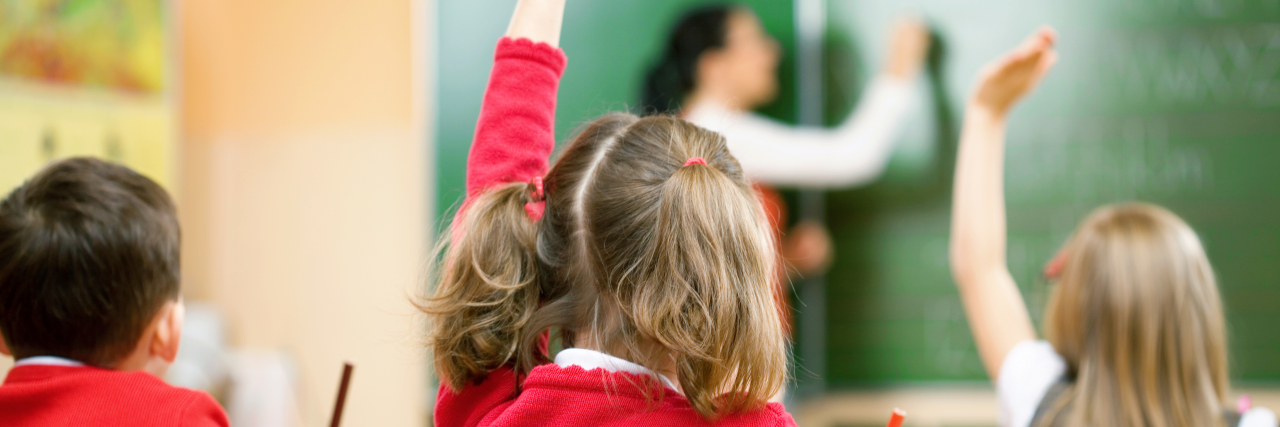When I was a young kid, there was very little research on nonverbal learning disorder, so I was diagnosed with a visual processing disorder. Like with a nonverbal learning disorder, people with visual processing disorder often have a poor sense of direction, messy handwriting, weak reading comprehension, significant spatial skill deficits, difficulty reading visual maps and outlines, and accurate copying details. These symptoms can make it especially difficult for teachers to see beyond students’ visual processing disorder because so much learning takes place visually, especially as you reach higher grades.
One of the most common classroom difficulties students with a visual processing disorder may face is being able to copy something presented visually to them — like class notes presented on a screen. While this seems like a “simple” task, students with visual processing disorder may lack the required visual skills, so this may become too much for them. As a result, sometimes teachers may think these students “aren’t listening” or see them “drifting off” due to their lack of focus. What is actually happening, though, is that due to their visual processing deficits, students may become overwhelmed and may not be able to remain focused on what the teacher is saying while they try to copy what is on the board. This is why they may seem disengaged.
In addition to classroom challenges, visual processing disorders can make navigating the world difficult. This disorder is a “hidden” disability, so it can be hard for others to understand all the challenges it brings — including navigating personal surroundings. Whether it be walking down the hall in between classes, finding your next class, or going to a friend’s house, navigating with weak spatial skills can bring a lot of frustration personally and for others too. With this disorder, visual information can’t be processed and saved into your memory, so going from place to place can be a challenge. Fortunately, strategies like following another student to class or making those around you aware of your visual processing struggles can make life much more manageable. Also, with today’s technology, this struggle may have more solutions, as many phones and GPS apps read directions out loud.
Due to these difficulties, making friends can be hard at times, and it isn’t necessarily connected to social skills difficulties. Moderate to severe visual deficits can cause peers to be impatient and confused about what is “wrong.” For example, a game of kickball can be a challenge, and riding a bike may be nearly impossible. Doing less active activities — like putting together a puzzle or playing video games can be difficult too. Therefore, it can be hard to socialize with peers because they may not understand the challenges their friends with visual processing disorder have with playing. However with more awareness and acceptance of visual processing disorder and other disabilities, you may end up with a great group of friends.
One way to treat a visual processing disorder is with occupational therapy — which is effective when it begins early. Occupational therapy helps people with visual processing disorder coordinate their hands and eyes — visual processing disorder can cause deficits in this area. Things like reading out loud, using bright highlighters, and playing with puzzles may be things children with visual processing disorder do in occupational therapy.
For older students, overcoming a visual processing disorder may be geared more towards academics and homework completion. Reading out loud can improve visual processing skills, but the academic support students receive may change as they get older. Occupational therapy is often removed from older students’ IEPs.
Not everything that may help students with visual processing disorder is a service for students with disabilities. Being in a sport, like cross-country, can be a wonderful experience for students with this disability. Being on a sports team can help you form great personal connections with coaches and teammates. More importantly, for cross-country, you are required to use your visual processing skills often with trail running and running routes around town. With hard work and dedication, students may not even realize that they are improving their visual skills while having fun being part of a team.
A hard part of visual processing disorder, though, is that it doesn’t go away — it just becomes more manageable with good coping skills. For example, I still struggle with directions and need to understand it will take me a longer time to get from place to place and that I may need to take a cab or rideshare instead of trying to go on my own. Furthermore, even something as “simple” as emptying the dishwasher can be difficult — especially if it includes a lot of fragile dishes that can break easily. On a positive note, though, I can be honest with myself about my deficits, and fortunately those around me are really accepting, so I often get the help I need.
Overall, while visual processing disorder may seem complex and difficult, it can often be improved by taking advantage of support services like occupational therapy and being honest with yourself and others about your struggles. Not being aware of your challenges can make life with visual processing disorder harder — especially if you continue to bump into people or struggle with chores like putting the dishes away. I have always been honest with myself about what support I needed and this allowed me to have the successes I have had in my life with visual processing disorder.
Getty image by izusek.

